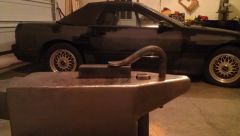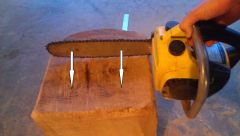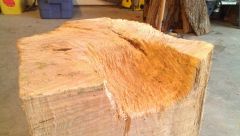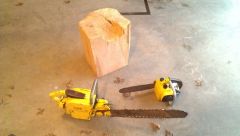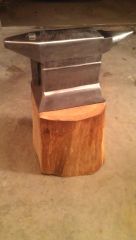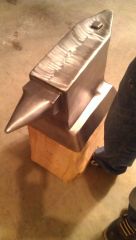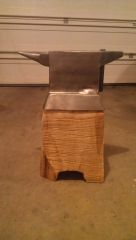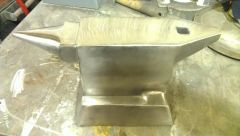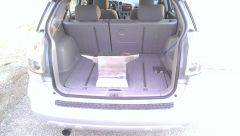-
Posts
84 -
Joined
-
Last visited
Content Type
Profiles
Forums
Articles
Gallery
Downloads
Events
Everything posted by stromam
-

My first anvil build - looking for advice
stromam replied to stromam's topic in Anvils, Swage Blocks, and Mandrels
I originally just had it in there because I was using that bar to check the hardy hole fit. After pounding on the anvil a few times with it/without it I noticed that the bar helps deaden the ring. It wedges itself against the tapered base of the anvil and apparently changes the resonant frequency. I did recently grind the edge of the bar down so the bar slides further down the taper of the base and the top of the bar lies below the face of the anvil (so it doesn't get in the way). If I want to use the hardy hole, just a quick tap from the bottom and the bar flies out. You can kind of see it better in this picture: I have also installed a couple eye-bolts into the stump with springs and turnbuckles. One has a hook that will act as a hardy hold down, one has another eye-bolt that holds onto the end of the horn and further deadens the ring. Even with it not yet fully mounted there is almost no ring. I'll post more pictures in either this or the stump build forum once I finish mounting it. -

My first anvil build - looking for advice
stromam replied to stromam's topic in Anvils, Swage Blocks, and Mandrels
And I finally got to use it! Here is what I made. I wasn't setting out to make that, I just started by drawing out some stock, tapering, rounding, upsetting, bending, cutting, etc. Eventually I had a piece that looked perfect for a hold down tool so I just made an extra bend, drawed/drew (past tense of draw?) the 5/8" round stock to fit loose in my 5/8" pritchel and flared the end. I've also made a round punch and started on a pair of tongs. I hosed the tongs up pretty bad, so no pictures yet. Right now I've got to make some modifications to my forge before I try to do anything else. I made somewhat of a 55 forge, but made the mistake of having the air pipe come up through the middle of the drum lid protruding about 3" into the coal bed with the end capped and holes drilled around the circumference of the 3" protrusion. I thought that may do a better job of diffusing the air... which it does... too good. It burns up TONS of charcoal and has about 4 or 5 hot spots around the perimeter of the pipe. I went through about 10 gallons of pine charcoal in less than 3 hours and I had a tough time getting the metal heated quickly. I'm gonna try a side blast bucket design to give me a nice deep 8" fire pit. On a side note, anyone interested in a 1988 Mazda RX7 convertible? The engine/transmission are in decent shape, just needs interior/exterior work and could use some new shocks (they still work, just a bit rusted). On a second side note, anyone want to come help me organize my horribly messy work bench? I'm kind of embarrassed by this photo, but the work bench is really cool. It was my grandfather's and he was a craftsman (wood, metal, engines, boats, you name it!). There are a bunch of cool old tools in it and the bench itself is made out of solid oak, it weighs a TON! -

My first anvil build - looking for advice
stromam replied to stromam's topic in Anvils, Swage Blocks, and Mandrels
Made a stump which can be seen here if you haven't already found it: http://www.iforgeiron.com/topic/31887-my-first-anvils-stump-build/ Haven't mounted it yet because I'm going to make another stump that's a bit taller. Right now I'm playing with the height by screwing pieces of 2x4 under the feed to raise it up. Once I figure out how tall I want it I'll make another one and mount it firmly. -
-

My first anvil's stump build
stromam replied to stromam's topic in Anvils, Swage Blocks, and Mandrels
I am wondering what other people have to say about the undersize/ridiculously oversize anvil stand? I've heard some people say they like to work VERY close to their anvils (maybe it depends on if you are doing heavy striking or delicate work). What do you mean by "the used of iron is a must". Do you mean in mounting the anvil to the stand or in keeping the stand from splitting. How would you tighten straps further after bolting them down the first time? -

My first anvil's stump build
stromam replied to stromam's topic in Anvils, Swage Blocks, and Mandrels
My anvil ended up about 1-1/2 inch short of reaching my knuckles. I tried it out a bit last night and had a hard time holding my stock level with the face without bending over. I have basically 4 options at this point. 1. I can leave it and learn to use it. 2. I can try to find another stump (maybe bigger diameter too) which would also give me the opportunity to correct some of the mistakes I made on this one. 3. I can make a spacer between the anvil and the stump either out of another stump or 2x4s or a piece of steel or something, then silicone it in place. 4. I can make a platform out of 2x4s to set the anvil/stump on top of. That would allow me to either use it at knuckle height, a couple inches lower for heavy hitting, or I could raise the platform and use it a couple inches higher for more detailed work. Thoughts/recommendations? -

My first anvil build - looking for advice
stromam replied to stromam's topic in Anvils, Swage Blocks, and Mandrels
Finally got around to the rebound test now that it is somewhat firmly seated on the stump. Something very strange happened. The rebound of the hardened face was about the same as the rebound of the unhardened step/upsetting area. I thought for a while that something was very wrong with the manganese steel until i realized there is a coating of shellac on the entire hammer head. I sanded that coating off and WOW what a difference. The unhardened areas give a light thud and two or three minor bounces. The hardened face gives a high pitch "TING" with a VERY good rebound (as best as I can tell from my zero years of experience). The hammer bounces across the anvil face so many times, if I'm not careful it bounces itself right off the edge. It still has a ways to go on work hardening, because if I don't hit it square with the hammer, it leaves a dent from the corner of the hammer. I also made the mistake of striking a cold bar of square stock laid flat on the face and it left a nice little bar shaped impression, granted probably not more than 0.002" deep, it still showed up on the polished face. It weighed out at 205 lbs. Just light enough to pick up by myself (although I probably shouldn't) and when mounted to the stump I can still slide it across the floor. Its heavy enough that a medium swing of a 2-1/2 lb hammer yields ZERO movement of the anvil. -
Here is the stump build for the anvil I made in another thread: http://www.iforgeiron.com/topic/31084-my-first-anvil-build-looking-for-advice/ It's not quite done, but I was able to get most of it done in a couple weeknights with the help of some awesome, old chainsaws i inherited from my Grandfather. Here is approximately what it will look like. On the near side I carved a foot hole so I can stand really close and try to save my already bad back. And the far side was left uncut so I can drill some holes for tool holders. These are the two saws I used and the only two power tools used to make the stump. The big boy is a late 1950s McCulloch 35A, which needed a minor rebuild and was used to chop the three sides. The smaller one is a McCulloch Mini Mac and I used that for all the detail work. Here is a closeup of my foot hole design, it also shows how I carved three "legs" into the base. With those legs, the stump sits perfectly flat on the ground, no rocking whatsoever. Its pretty stout. Sweet litterbox in the background, huh? I have seen a few posts of people using routers mounted on sleighs to flatten their anvil stumps, I went with the less sophisticated route, it also only took about 30 minutes start to finish and it is almost perfectly flat. Here is basically how I did it: First cut the base to a tripod so it sits flat on the ground, make sure it is where you want it because after you level the face, any adjustments to the feet will throw off the level. Next get a straight edge or level and lay it across the face at various places/angles. In each placement mark the pivot point of the straight edge. That is the high spot. I just put a squiggle with a sharpie to mark all the high spots. Knock down all the high spots until the face is flat. Then proceed to leveling (you can do this the same time as the flattening step). I lay the chainsaw down as flat as I can and slide it across the face as depicted below, using very quick passes, maybe 2-3 seconds to skim across the whole thing. This brings down one side or the other, but keeps the whole thing flat. It takes a lot of passes, but at 3 seconds a piece you can do 20 passes in a minute (which is enough to take off probably 1/4-1/2 inch across the whole face). Repeat the whole process until you get it as flat and as level as you want. No building frames, sleds, etc. Just start up the chainsaw and have a straight edge and sharpie on hand. I'll post some more pictures as I finish the last details. The key to working with a chainsaw for shaping, which I'm sure everyone would learn very quickly is never to stop moving the chainsaw, if you do it bites in and cuts a deep slot. Don't even use the weight of the chainsaw, maybe only 1/4-1/2 the weight, it is amazing how quickly it will skim the surface down if you aren't careful. One question, anyone have recommendations for preserving the wood? It is still pretty wet and I don't want to let it crack too badly. I was thinking about just coating the whole thing with boiled linseed oil or a nice wood stain.
-

My first anvil build - looking for advice
stromam replied to stromam's topic in Anvils, Swage Blocks, and Mandrels
So I just found out when trying to level my stump last night that the face of my anvil as well as the base are slightly convex. I don't care about the base because I'm going to silicone it to the stump, so it doesn't have to be perfectly flat, what I'm worried about is the curvature of the face. It is flat from one side to the other, but from heel to horn there is about a 3/16" difference from one end to the other. Should I go through all the trouble of taking it back to the shop, re-welding/re-grinding the face to bring it closer to flat? Is it really that big of a deal? I do have a couple relatively flat areas to work on, it is mostly a slight curve about 3" in from the step and at the point the heel meets the body. -

My first anvil build - looking for advice
stromam replied to stromam's topic in Anvils, Swage Blocks, and Mandrels
Just finished rough cutting my anvil stand, I'll post pictures on here tomorrowish. I did do a "3 legged" stump stand, with a little extra meat on the far side for tool holders. I'm also going to do a couple hold downs for the horn/heel to reduce the ring. I'm also planning on just silicon gluing the anvil to the stump to eliminate the need for fasteners. I think the silicone over that much surface area will be very unlikely to release. annealing did soften the whole anvil, but not the hard facing on the top. Well i guess technically it did soften it, but only down to 20-30C, but since it is work-hardening manganese steel it will harden back up to 50ish with use. So far I've had no problem leveling my stump out, and with 3 legs it sits VERY stable on the ground. I am curious how I should protect it from rot/insects. I was just planning on coating the whole thing with boiled linseed oil. Is that enough? You are absolutely correct. The work hardening rod is still relatively hard after annealing and will harden further with use. -

The "Baby Fisher" Rally!!!
stromam replied to Pulsepushthepopulace's topic in Anvils, Swage Blocks, and Mandrels
It ended for $21 -
I like this solution the best. Why destroy the best mount you've got? Just re-purpose it!
-

Using a chisel as an anvil?!
stromam replied to caotropheus's topic in Anvils, Swage Blocks, and Mandrels
They may even have a big bandsaw that could handle it, if that's the case they may do it for free if you sweet talk them. Just warn them it might be hardened, they may not care and their saw may be able to handle it. You could always take a hacksaw to it to test if it can be cut with metal. -

Using a chisel as an anvil?!
stromam replied to caotropheus's topic in Anvils, Swage Blocks, and Mandrels
Find a fabrication shop that has a laser or water jet, they can probably cut it in about 2 minutes once the get it in the machine. I bet they wouldn't charge more than $20, which you would probably spend in grinder cut off wheels. -

My first anvil build - looking for advice
stromam replied to stromam's topic in Anvils, Swage Blocks, and Mandrels
This is a test of the multi quote system. I'm going to try to make a new thread with just the build posts to make it more concise. -

My first anvil build - looking for advice
stromam replied to stromam's topic in Anvils, Swage Blocks, and Mandrels
I let her cool off over the weekend and here it is after removing the pyro block. it was kind of strange, when I rubbed away the dark red rust (bottom half) it turned into the bright orange rust (top half), which didn't rub off further without an abrasive. The layer of scale was very thick and part of me wishes I had left it on. I used a twisted wire cup attachment for the grinder to remove the scale and the other part of me is glad I took it off because... ... it looks so good. I went back and forth using the twisted wire or a flap abrasive attachment, the flap would have polished it up to be shiny, but the twisted wire gave it a more grey/aged dull texture which I decided i preferred (also a lot less work than jumping grits to try and polish the whole thing). I did polish the face, the step and the top of the horn. I also put a couple different size radii on the corners of the base, the largest one is on the near left side. This picture shows well the concave radius I made at the right side of the upset block. Not sure what I'll use it for, but I'm sure it will come in handy. I added a unique feature to the far side of the anvil, a couple small steps which I think would make a good place to do scarfing for forge welding, or just making different textures/bends/features etc. And finally here she is, cleaned and loaded up in the back of my girlfriend's car. Props to her for putting up with me staying late so often to do this project. All together I think I've put in the ballpark of 50 hours to complete this project. Final weight - 205 lbs. Now I just need to get my stump stand ready. I've got a couple rough cut stumps in my garage, but to cut them straight I need to get my grandfather's 1950s McCulloch 35A chainsaw rebuilt. Until then I'll just have to admire my work. Oh, one last thing. Even after heat treating I had trouble drilling the pritchel hole with standard drill bits in a magnetic drill. I'm going to take the anvil to my machinist and he is going to help me drill them with some carbide bits. Lincoln electric said it can be done, it just won't be easy. They recommended cobalt bits, but I looked them up and they are about $100 each. Ouch, make sure to drill any holes first... I just got excited and forgot. -

My first anvil build - looking for advice
stromam replied to stromam's topic in Anvils, Swage Blocks, and Mandrels
Final build pics here we come: First here are a couple of the temporary oven I built around the anvil. I set it on top of a couple pieces of 1" square stock and put another piece along the length of the top so the top didn't get insulated. I used the propane burner from my homebrew setup, its a high pressure burner, I believe 30,000 BTU/hr. I built the temporary oven with pyroblock we use to line our furnaces. I thought these pictures were cool because you can get a good feel for the colors of steel as it heats from 400-700 F. My camera takes pictures that are pretty true to color so I thought I'd share. This one is cool because you can see both where I accidentally welded with some stainless rod and you can see the layer of hardfacing on the top. The manganese steel on top also went through the color shift, but I believe it happened at a much higher temperature. The horn is at red heat, granted it heats up a lot quicker, the steel on the main body directly below the hardfacing had already passed the purple/blue phase at 600 F and was at a very light blue/grey (i'm guessing 800-900 F) and theoretically they are in thermal equilibrium. About 4.5 hours into heat treatment, i finally achieved red heat (my camera doesn't do infrared temperatures very true, it was actually bright cherry not yellow) at about 1500 F. I kept it there for about 30 minutes to allow it to heat soak a little more. I am glad I had two propane tanks on hand because the first one got so cold the gas pressure dropped and the flame actually started dying down about 2 hours into it. The same happened with the second tank about 4 hours in.

